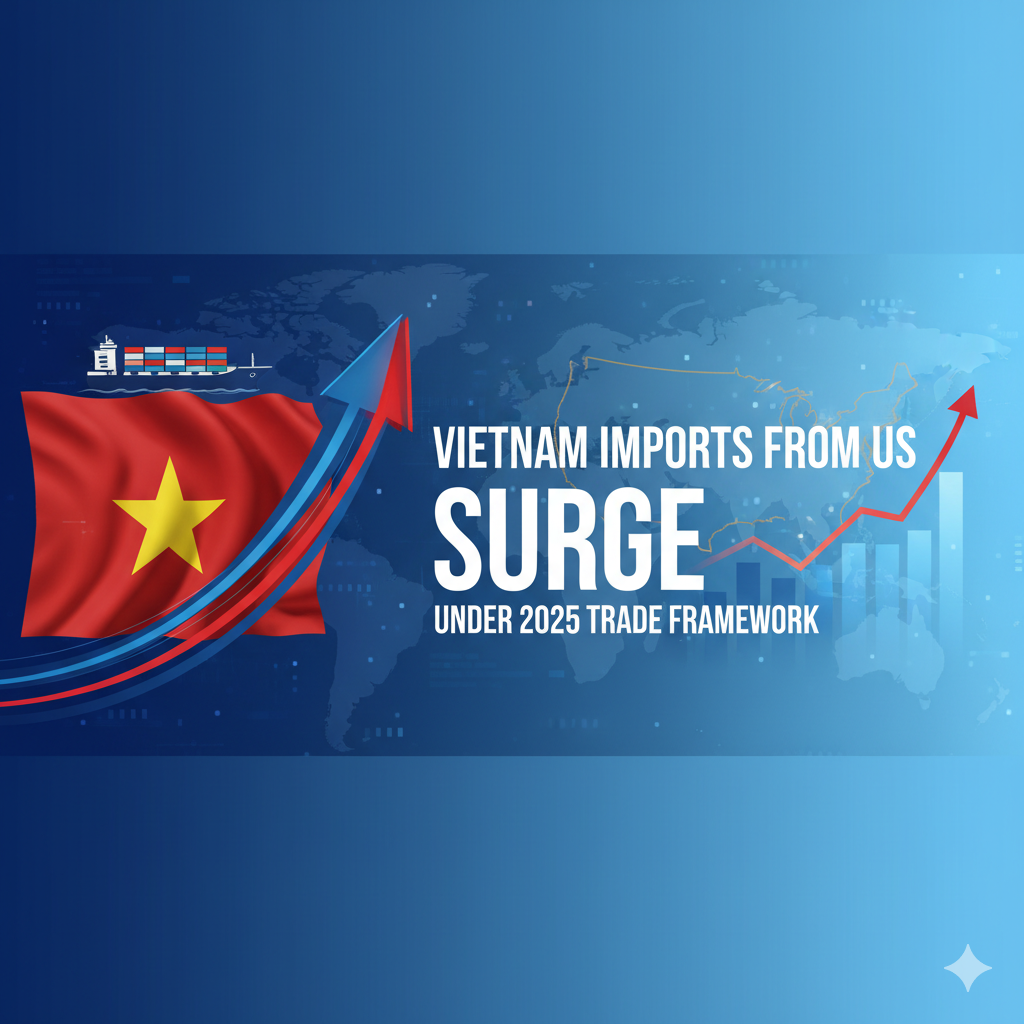Vietnam Imports from US Surge Under 2025 Trade Framework
The year 2024–25 marked a major turning point in the economic partnership between Vietnam and the United States. The two nations, once distant in trade relations, have evolved into crucial partners shaping the Indo-Pacific economic landscape. According to Vietnam import customs data, total trade between both countries reached $149.5 billion in 2024, positioning Vietnam as America’s seventh-largest trading partner. Meanwhile, the United States became Vietnam’s largest export destination, underscoring the deep interdependence of both economies.
The Rise of Vietnam Imports from US
In 2024, Vietnam imports from US totaled $14.98 billion, a significant 33% increase from the previous year. This surge reflects Vietnam’s growing demand for high-quality American goods — from advanced machinery and medical devices to agricultural products and chemicals. While the U.S. imported over $136 billion worth of goods from Vietnam, the trade imbalance remains large, with Washington recording a $123 billion deficit.
However, a new chapter began in late 2025 with the signing of the U.S.–Vietnam Trade Framework Agreement. This deal, designed to reset trade ties, provides reciprocal benefits: Vietnam will open its markets wider to U.S. goods, while the U.S. maintains a 20% tariff on Vietnamese exports but offers exemptions for key categories such as electronics, apparel inputs, and furniture.
What Does Vietnam Import from the US?
To understand the growing economic interconnection, it’s important to explore what does Vietnam import from the US. Vietnam imports a diverse range of goods, including electrical machinery, agricultural products, plastics, cotton, and high-tech medical devices. These imports are crucial for Vietnam’s industrialization and modernization efforts.
Based on Vietnam import customs data for 2024–25, the top Vietnam imports from the US include:
-
Electrical Machinery & Equipment (HS Code 85) – Valued at $4.54 billion, this category tops the list. Vietnam’s booming electronics and manufacturing sectors rely heavily on U.S. electrical machinery, semiconductors, and power distribution systems.
-
Prepared Animal Food (HS Code 23) – Worth $1.01 billion, this category reflects Vietnam’s expanding livestock and aquaculture industries. American animal feed supplements and pet food products are in high demand.
-
Plastics and Articles Thereof (HS Code 39) – With imports totaling $1 billion, the U.S. supplies high-quality plastic products and resins that power Vietnam’s packaging and manufacturing sectors.
-
Cotton (HS Code 52) – Valued at $681.59 million, U.S. cotton is a vital raw material for Vietnam’s textile industry, one of the country’s major export drivers.
-
Pharmaceuticals, Medical Devices & Chemicals – Combined imports exceed $1.6 billion, including pharmaceutical products, medical instruments, and inorganic chemicals essential for healthcare and agriculture.
These figures illustrate that Vietnam imports from US are not just about consumption — they are about production, growth, and technological advancement.
Why Vietnam’s Imports from the US Are Rising
The growth in Vietnam imports from the United States is driven by three main factors:
1. Industrial Modernization:
Vietnam’s shift toward high-value manufacturing requires advanced equipment and precision technologies, much of which come from American firms.
2. Agricultural Needs:
With a rapidly growing middle class and evolving food preferences, Vietnam relies on the U.S. for soybeans, corn, animal feed, and fruits — key inputs for its food and beverage industries.
3. Healthcare Expansion:
Vietnam’s healthcare sector has expanded quickly. U.S. medical devices and pharmaceuticals are recognized for their quality, driving rising imports in this segment.
In early 2025, Vietnam imports from US surged again — reaching $7.5 billion in just the first half of the year, up 21% year-on-year. Cotton imports rose by 116% in volume, while U.S. fruit and food products jumped 43%. This trend underlines how what does Vietnam import from the US is diversifying beyond raw materials into higher-value goods.
The Impact of the 2025 Trade Framework
The 2025 U.S.–Vietnam Trade Framework marks a significant policy evolution. Its core provisions include:
-
Tariff Reductions: Vietnam agreed to lower tariffs on nearly all U.S. imports, especially agricultural and industrial goods, to 0–5%.
-
Regulatory Alignment: Vietnam will recognize U.S. standards for machinery, vehicles, medical devices, and pharmaceuticals.
-
Digital Trade & Data Flow: The framework ensures cross-border data transfers and no customs duties on digital goods — a major win for U.S. tech companies.
-
Transparency & SOE Reform: Vietnam committed to ensuring fair competition for U.S. firms against state-owned enterprises.
For U.S. exporters, this deal represents an opportunity to expand their footprint in one of Asia’s fastest-growing economies. For Vietnam, it means access to world-class technologies, energy solutions, and industrial inputs that can power its next phase of growth.
What Does the US Import from Vietnam?
While much attention is on Vietnam imports from US, it’s worth noting what does the US import from Vietnam. American consumers heavily depend on Vietnamese-made electronics, textiles, furniture, and footwear. In 2024, U.S. imports from Vietnam reached $136.6 billion, up 19% from 2023. The top categories include:
-
Electronics and semiconductors
-
Textiles and garments
-
Footwear and leather goods
-
Furniture and wood products
-
Seafood and agricultural goods
This asymmetry explains Washington’s concern over the large bilateral trade deficit. Still, both nations see the framework as a tool to balance trade while strengthening supply chains.
Why the Relationship Matters
Vietnam’s import behavior reflects its broader strategic goal: diversifying away from regional dependency on China. By increasing Vietnam imports from US, the country gains access to advanced technology and enhances its industrial self-reliance.
At the same time, the U.S. views Vietnam as a crucial partner in Southeast Asia — both economically and geopolitically. Deepening trade links ensure supply-chain resilience, expand American market reach, and promote democratic trade norms in the region.
Key Growth Sectors for 2025 and Beyond
The following sectors are expected to see the strongest growth in Vietnam imports from US:
-
Semiconductors and Electronics Equipment: As Vietnam builds a domestic semiconductor hub, demand for U.S. components and tools will surge.
-
Agricultural Products: U.S. soybeans, dairy, and meats will gain ground due to lower tariffs.
-
Medical & Pharmaceutical Supplies: Vietnam’s healthcare expansion opens opportunities for U.S. life sciences companies.
-
Energy and Environmental Technologies: American clean-energy hardware and emission-control systems fit Vietnam’s green growth strategy.
-
Digital Services: New digital trade guarantees make Vietnam one of the most open markets in Southeast Asia for U.S. tech and cloud services.
Challenges Ahead
Despite the optimism, challenges remain. Vietnam import customs data suggests that logistical costs, regulatory inertia, and currency pressures still pose hurdles. The success of the framework depends on effective implementation, mutual compliance, and continued dialogue between both governments.
Conclusion
The 2025 U.S.–Vietnam Trade Framework represents the most significant evolution in bilateral trade relations in over a decade. It’s not just about tariffs — it’s about transforming how two dynamic economies collaborate.
While Vietnam imports from US remain smaller compared to its trade with Asian neighbors, they are rising fast and shifting toward high-value, technology-driven goods. With tariff cuts, improved market access, and stronger digital and industrial cooperation, the partnership is poised to double in value within a few years.
In essence, what does Vietnam import from the US today — high-tech machinery, advanced agricultural products, and medical technologies — reflects the country’s future ambitions. And as trade barriers fall, Vietnam imports are set to become a cornerstone of its modernization journey.













